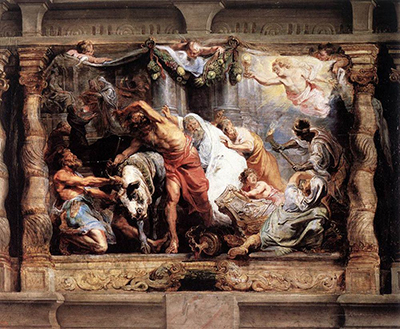This enchanting artwork was completed by Peter Paul Rubens in around 1625. It is on display at the world famous Museo del Prado in Madrid, Spain, as part of a series of this artist's work within their collection.
This painting was one of many designs produced by Rubens as preparation for later tapestries. He would hand over the painted pieces to weavers to construct the final artworks that would then be hung in a pre-agreed location. The Museum in Madrid owns the original paintings that were produced on panels, six of them, though the tapestries planned would total twenty. The large project was commissioned by Archduchess Isabel Clara Eugenia in 1625 and the artist, with the aid of several assistants from his studio, would start work pretty much straight away. The overall style is highly typical of both Rubens himself but also the Flemish Baroque approach more generally. Several amendments were made to the panels in the 18th century but these have since been removed in order to keep these artworks as faithful to the original work of Rubens as possible.
The composition features a large amount of Christian symbolism, such as with the fox, representing Heresy, who is overcome by the powerful and noble lion at the very bottom of the painting. You will also find figures here representing different denominations such as Muslims, Jews and Protestants. The dragon is believed to represent evil itself and it is entirely common for artists of this period to use art to display a battle between good and evil in fairly simplistic terms.
The Museo del Prado in Madrid offers a survey of European art unrivalled anywhere in the rest of Spain. All of the great masters are to be found here, with a particular focus on those from this nation, though with Flemish and Italian artists also well represented. Much of the best of the nation's art has been collected together and displayed here, having previously been stored at the Royal Palace. Besides further artworks from Rubens, you will also find Goya here as well as Diego Velazquez and the likes of Bosch and Durer as well. It really is a who's who of art from the Renaissance and Baroque periods and serves as an incredible introduction to these two major art movements for those looking to better understand the more traditional periods of European art.




